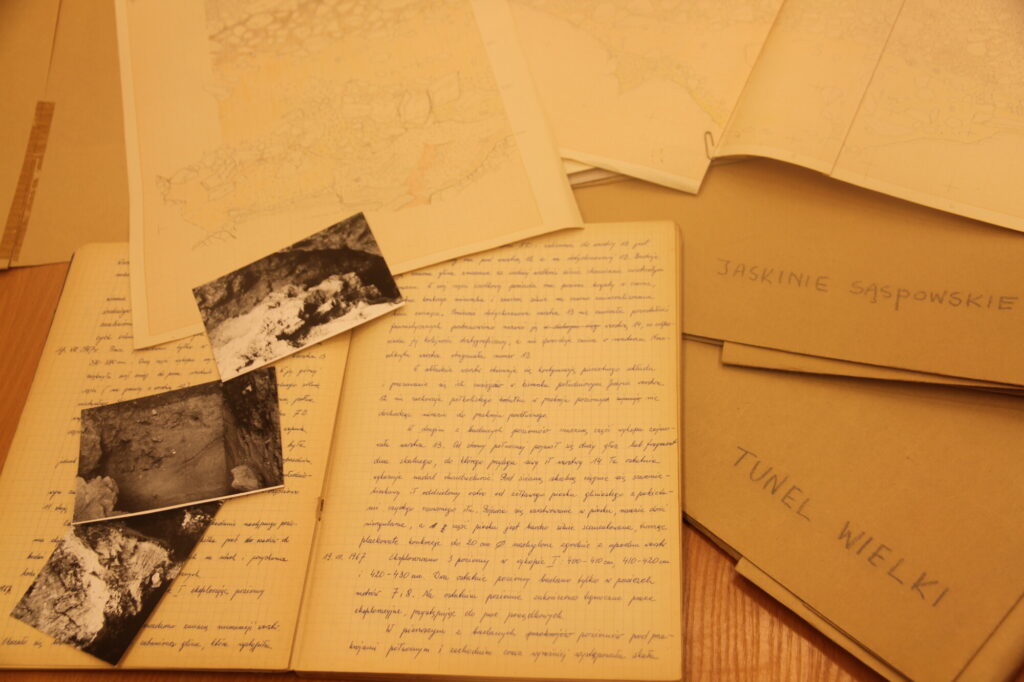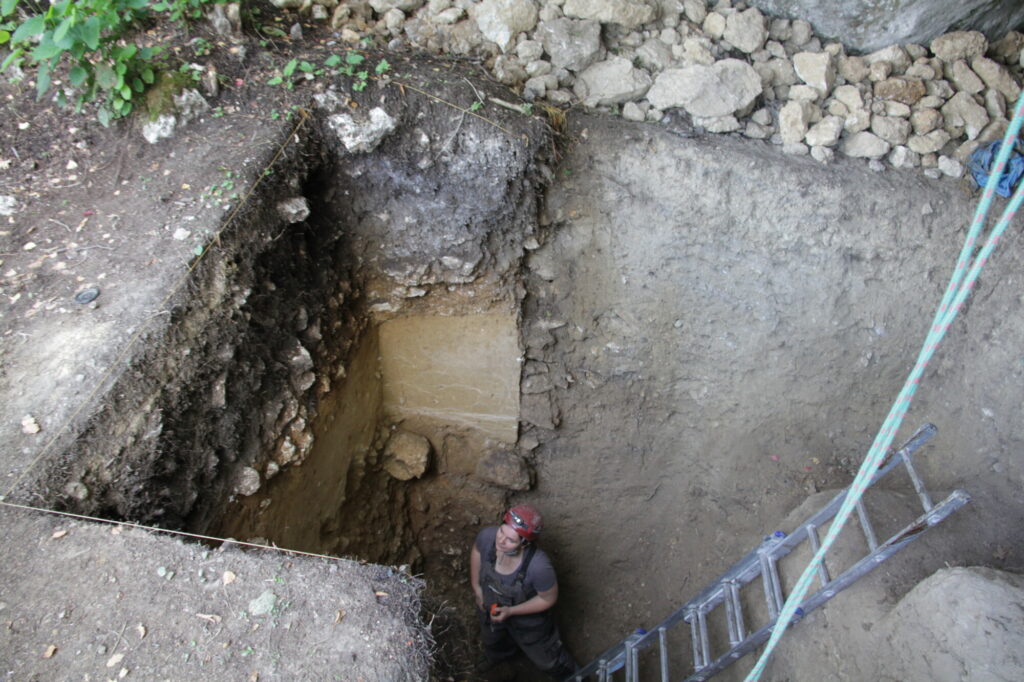I open a long lost box of artefacts. Do you know this feeling? The feeling when you discover notes for a book, written with your own hand, which you think you read for the first time? We call it the archaeology of archaeology.

© M. Jakubczak, CC BY-SA 4.0 licence
I have always loved caves, but this project began in a quite different manner. It was early spring in 2015, I had just earned my PhD. We were emptying the old storerooms of the Institute of Archaeology and moving the materials to a new location. It was the first opportunity in many years to clean up and organize artefact collections. One day our colleagues started to show up at the Department of the Palaeolithic with boxes, asking whether this could be our material since they bore the name “cave” and there were flint pieces inside. We began to look through the boxes.
In some of them the artefacts were wrapped in newspapers or brown paper and tied with twine. I realized that nobody opened these boxes since they were filled and closed after excavations. We could barely read faded pencil labels on the withered papers. The names of the sites – “Ciasna Cave”, “Sąspowska Cave East”, “Iłowe Rockshelter”, “Kamieniste Rockshelter”, “Bramka Rockshelter” rang the bell. The common denominator was the fact that all of them were excavated by the late Professor Waldemar Chmielewski, an eminent scholar and researcher of the Palaeolithic. He coined the term “Jerzmanowice culture” and explored the caves of the Ojców Upland for many years.

© M. Myszkowski, CC BY-SA 4.0 licence
In 1967-1993 the Professor headed a project whose aim was to excavate all unexplored caves accommodating settlements within the boundaries of one valley, the Sąspowska Valley. The most intensive work was conducted in the 1960s and early 1970s. Later on, in 1993, he returned to explore one more site. During all these excavation seasons he managed to study 14 caves situated in the Sąspowska Valley, in the very heart of the Ojców National Park.
A stream called Sąspówka flows across the bottom of the valley, its sources can be found directly in front of the entrance to two caves: Sąspowska Zachodnia Cave (Sąspowska West) and Sąspowska Wschodnia Cave (Sąspowska East). The Sąspówka meanders on, cuts deep into the limestone rocks which form several dozen caves and finally, 4.5 km further, it joins the Prądnik River in Ojców. Professor Chmielewski’s project of exploration of all the caves was a very ambitious venture: it made it possible for the first time in the history of Polish (or perhaps even European) archaeology to compile a study regarding exploitation of caves in a closed micro-region – Sąspowska Valley.

© M. Bogacki, na licencji CC BY-SA 4.0
However, the plan to explore all the caves of the Sąspowska Valley has never been completed. After the excavations, conducted in cooperation with geologists and palaeontologists, the bone material was sent to the Institute of Systematics and Evolution of Animals of the Polish Academy of Sciences in Cracow, the geological samples to the Institute of Geological Sciences of the Polish Academy of Sciences in Warsaw, and the artefacts were sent to the University of Warsaw, where the Professor worked at that time. The only analysis connected with these long years of studies was compiled in the 1980s, and it was a summary of the research from the perspective of geology and palaeo-environment. The artefacts have never been analysed or published. Three master’s theses were written on the basis of selected materials. Most of the artefacts – as it turned out – were not even removed from the boxes. Since their discovery the materials were moved to different places and lost.
And so in March 2015 I faced a pile of cardboard boxes and pondered about their value. An artefact without its context presents a low value to an archaeologist. We started asking questions and looking around. We found out that the documentation of exploration of these caves survived among the materials left by Professor Chmielewski. The yellowed sheets of A2 graph paper show drawings of sections in colour, detailed excavation maps with indicated places of discovery of bones and artefacts, diaries and inventories of artefacts. We found what we needed. Our excitement rocketed. We made a quick inventory to learn what else we should find. It turned out that some of the materials and parts of the documentation were actually missing. We kept looking. One of the Professor’s former graduate students had the material from Bramka Rockshelter. She analysed it for her master’s thesis and then did not know where to return the boxes after the Professor’s death, so she kept them. We were less fortunate with the rest of the artefacts. Nevertheless, colleagues from other institutions helped. The Institute of Archaeology and Ethnology of the Polish Academy of Sciences gave us documentation and some boxes which were mistakenly delivered to their institution after the Professor’s death. Not everything was found. For example, almost all the artefacts from Sąspowska Zachodnia Cave and a child’s skull from Tunel Wielki Cave have been lost. Eventually, we identified about 90% of the documentation and almost all archaeological artefacts.
This is how our project began. It was planned as merely an analysis and publication of the results of Professor Chmielewski’s research. However, it turned into an amazing interdisciplinary adventure in the world of caves and people who lived in them, used them as temporary camps, buried their dead inside, and sometimes simply looked for shelter there. The burial of a girl with a finch’s skull in her mouth, the oldest relics of human presence in Poland, remains of a pottery workshop with a pottery firing kiln unearthed in a cave, a clay rattle and the first cave camp of Mesolithic hunters in Poland – these are just a few items of a long list of discoveries from the Sąspowska Valley hidden in the misplaced boxes for over 50 years.

© M. Dzierlińska, CC BY-SA 4.0 licence
Five years ago I believed it was an uncomplicated project which would not take long to complete. The plan seemed simple. We analyse the preserved historical materials, excavate old trenches at selected sites to check the layer patterns and take samples for laboratory tests. I did not know that each successive box, artefact and analysis would open new areas of research for new questions. The deeper we sank in our world of caves, the more questions emerged in our minds, after some time – also of general nature. What caves were preferred for camps? Can we distinguish between caves used for different purposes? How come there are so many human bones in the caves? How old are these bones? What was the age of the dead? Were these people related to each other? Are all, or at least some of the artefacts connected with these bones? Were they burials? Did those who were buried in the caves live nearby? Modern archaeology, thanks to cooperation of scientists from various disciplines, gives us many answers. As a result of the work on this project, financed by the National Science Centre, an international interdisciplinary team of over 30 researchers from almost 20 scientific institutions was established.
It soon turned out that we could not limit our activity to the analysis of Professor Chmielewski’s research because in some of the caves of the Sąspowska Valley excavations had also been carried out earlier: in the 19th century. We learned about some of these studies when we searched through the archives. We began to find previously unknown artefacts from the caves that we studied. In order to reconstruct details, we also referred to information about the area situated close to the caves. The research conducted in the 1970s revealed that there was a very large flint quarry at Sąspów in the Neolithic, and several smaller ones were located along the edge of the valley. We were aware of the fact that during this period, at least some of the caves we studied, must have been used in the context of existing flint mines (for example, they were used as accommodation for the quarrymen). So we analysed the Polish Archaeological Record, we also conducted a LiDAR analysis and looked for a context associated with settlement activity in our caves. What we found, however, exceeded our wildest expectations.
I would like this text to be the beginning of a journey around the world of the caves of the Sąspowska Valley. Over the next few months we will present the results of our research to you and we will show you that modern archaeology cannot do without assistance of other scientific disciplines: palaeontology, palaeobotany, genetics, geology, anthropology, biochemistry, and without a series of laboratory analyses, from radiocarbon dating to computed tomography or isotope analyses. In the following weeks we will present not only the results, but also the sciences supporting research on the human past. We want to ask our colleagues a little awkward question: how they feel about working with archaeologists, what they hate about us and what fascinates them. Perhaps also whether working with us adds value to their own research.
From the perspective of five years of being involved in the project – when it is approaching completion – I believe that if all these artefacts had been analysed in the 1970s, many of the questions we were able to answer might have remained unanswered. Archaeology has gone through an astonishing change over the last few decades. This story will also be about that.
Author:
Małgorzata Kot – archaeologist. She is fascinated by Neanderthals as well as their relations with Denisovians and modern humans. She conducts her research in the western piedmonts of the Tian Shan in Central Asia. She also studies caves in the Kraków-Częstochowa Upland, which can reveal more interesting stories than just the secrets of the last Neanderthals.
More texts by this author
This text was funded by project entitled “From caves to public: A series of popular science articles published on the archeowieści.pl blog, showing a multidisciplinary approach in archaeology, based on the results of our researches in the Ojców Jura” from Inicjatywa Doskonałości – Uczelnia Badawcza programme. Research on the caves of the Sąspowska Valley was funded by the National Science Centre, project: SONATA BIS 2016/22/E/HS3/00486.
References:
Project website: https://www.dolinasaspowska.uw.edu.pl
Editing: J.M.C.
Proof-reading: A.J.

3 Replies to “Caves in the Sąspowska Valley – the secrets of the storerooms of the University of Warsaw”